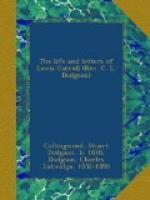Believe me, very sincerely yours,
C. L. Dodgson.
From June 7th to June 10th he stayed at Hatfield.
Once at luncheon [he writes] I had the Duchess (of Albany) as neighbour and once at breakfast, and had several other chats with her, and found her very pleasant indeed. Princess Alice is a sweet little girl. Her little brother (the Duke of Albany) was entirely fascinating, a perfect little prince, and the picture of good-humour. On Sunday afternoon I had a pleasant half-hour with the children [Princess Alice, the Duke of Albany, Honorable Mabel Palmer, Lady Victoria Manners, and Lord Haddon], telling them “Bruno’s Picnic” and folding a fishing-boat for them. I got the Duchess’s leave to send the little Alice a copy of the “Nursery Alice,” and mean to send it with “Alice Underground” for herself.
Towards the end of the year Lewis Carroll had tremendously hard work, completing “Sylvie and Bruno.” For several days on end he worked from breakfast until nearly ten in the evening without a rest. At last it was off his hands, and for a month or so he was (comparatively) an idle man. Some notes from his Diary, written during this period, follow:—
Nov. 17th.—Met, for first time, an actual believer in the “craze” that buying and selling are wrong (!) (he is rather ’out of his mind’). The most curious thing was his declaration that he himself lives on that theory, and never buys anything, and has no money! I thought of railway travelling, and ventured to ask how he got from London to Oxford? “On a bicycle!” And how he got the bicycle? “It was given him!” So I was floored, and there was no time to think of any other instances. The whole thing was so new to me that, when he declared it to be un-Christian, I quite forgot the text, “He that hath no sword, let him sell his garment, and buy one.”
Dec. 19th.—Went over to Birmingham to see a performance of “Alice” (Mrs. Freiligrath Kroeker’s version) at the High School. I rashly offered to tell “Bruno’s Picnic” afterwards to the little children, thinking I should have an audience of 40 or 50, mostly children, instead of which I had to tell it from the stage to an audience of about 280, mostly older girls and grown-up people! However, I got some of the children to come on the stage with me, and the little Alice (Muriel Howard-Smith, aet. 11) stood by me, which made it less awful. The evening began with some of “Julius Caesar” in German. This and “Alice” were really capitally acted, the White Queen being quite the best I have seen (Miss B. Lloyd Owen). I was introduced to Alice and a few more, and was quite sorry to hear afterwards that the other performers wanted to shake hands.
The publication of “Sylvie and Bruno” marks an epoch in its author’s life, for it was the publication of all the ideals and sentiments which he held most dear. It was a book with a




